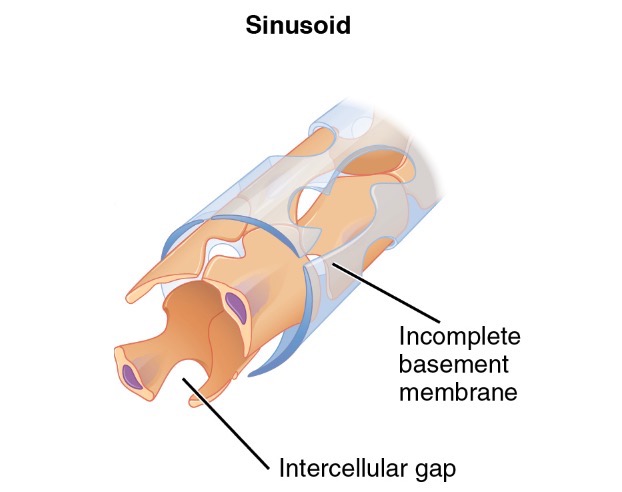Playlist
Show Playlist
Hide Playlist
Types of Endothelium
-
Slides Structure-Function Relationships Cardiovascular System.pdf
-
Reference List Pathology.pdf
-
Download Lecture Overview
00:01 Now let's talk about endothelium in kind of some of its other features. 00:05 So endothelium is not just a continuous sheet. 00:08 In some organs, it's fenestrated means it's got little windows, that's what fenestrae means in Latin, little windows. 00:16 And so it allows the diffusion of rather larger molecules. 00:20 A fenestrated endothelium occurs in the glomerular capillary tufts. 00:26 So we can get massive movement of smaller molecular weight things into the glomerular capillary space, Bowman's space. 00:36 On the right hand side are sinusoidal capillaries. 00:39 So these have even bigger gaps. 00:42 And these bigger gaps allow the movement of large molecules and even cells. 00:48 So in the liver, for example, the capillary beds that go down the sinuses of the hepatic parenchyma have rather large gaps. 01:03 And so there is a much larger series of holes. 01:10 And again, all of these have the same general organization of endothelium sitting on a basement membrane, but there just may be different ways that it gets organized. 01:21 So this is just showing you examples, again to repeat, and to confirm for you sinusoids have very big gaps, and typically see those in the liver. 01:30 Fenestrated endothelium can occur in the kidney. 01:35 And a continuous endothelium is almost always going to be the case within the brain because we really want to have a tight blood brain barrier. 01:46 Other kind of structure function and characteristics of the endothelium. 01:50 So under normal circumstances, that is to say, normal blood pressure, normotension, and laminar flow, nice smooth flow, not turbulent flow. 02:00 The endothelial cells would make a variety of growth factors to maintain normal activity, normal growth and normal non-adhesive. 02:12 So we're not going to recruit inflammatory cells if everything is good, we're not going to be making blood clot if everything is good. 02:19 That's the basal state. 02:21 Okay, but now if we perturb it, and we can perturb it in all those things on the left hand side at the bottom, including turbulent flow, hypertension, cytokines, bacterial products, hypoxia, acidosis, viruses, cigarette smoke, all those evil things will change the phenotype, will change the proliferative capacity and the synthetic capacity of the endothelial cells. 02:47 So we'll get increased expression of procoagulants, making it much more likely to clot. 02:51 We'll see more adhesive molecules, making them much more likely to recruit inflammatory cells. 02:57 And we will see more growth factors because that's likely the endothelium is going to be damaged, and we need to make more endothelium. 03:04 So that's the activated state. 03:06 So again, the endothelium is responding quite nicely to a variety of things in its environment. 03:14 That response may be functional and corrective and get us back to normalcy to homeostasis. 03:21 But it can also be dysfunctional. 03:24 And if we have enough bad things happening to an endothelial cell locally, it becomes adhesive. 03:30 So it's going to recruit inflammatory cells, it becomes prothrombotic, proinflammatory, it will make hypertension mediators. 03:39 So we will make things like endothelin. 03:42 And we will increase smooth muscle mitogenic activity, so we will increase the synthesis and proliferation of smooth muscle cells, which will end up making for a thicker wall, which may eventually occlude the lumen. 03:56 That is for an example, is something that happens in atherosclerosis.
About the Lecture
The lecture Types of Endothelium by Richard Mitchell, MD, PhD is from the course Structure-Function Relationships in the Cardiovascular System.
Included Quiz Questions
Which type of endothelium allows the kidneys to filter small molecular weight molecules?
- Fenestrated endothelium
- Sinusoidal endothelium
- Continuous endothelium
- Basal endothelium
- Atypical endothelium
In what state would one expect to find the endothelium in a diabetic patient with a gluteal abscess?
- The activated state
- The basal state
- The fenestrated state
- The transformative state
- The advanced state
What term would describe the endothelium of a preeclamptic patient with hypertension, edema, and proteinuria?
- Dysfunctional
- Resting
- Continuous
- Fenestrated
- Sinusoidal
Customer reviews
5,0 of 5 stars
| 5 Stars |
|
5 |
| 4 Stars |
|
0 |
| 3 Stars |
|
0 |
| 2 Stars |
|
0 |
| 1 Star |
|
0 |





